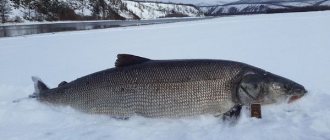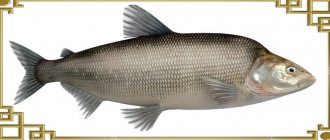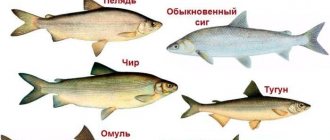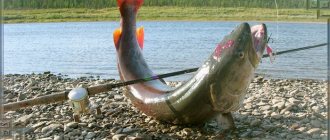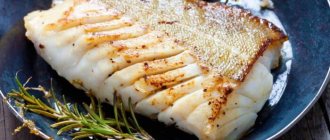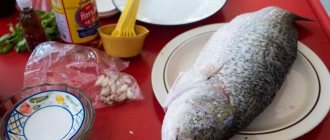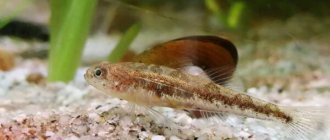Muksun fish are often called northern whitefish, and this is not a mistake.
It belongs to the whitefish genus, the salmon family, and is a dietary and delicacy product.
This northern fish is highly valued by local residents and fishermen. In cooking, muksun is in special demand.
Muksun is a true representative of the whitefish family, his appearance directly speaks of this.
The body of the fish is elongated, laterally compressed, the head and tail are slightly raised upward.
Adults have a noticeable hump. The color of the muksun is impressive - it is a beautiful silvery fish, the back of which is somewhat darker.
The sides of the fish are covered with silvery scales, the belly is white.
This color is typical for river fish; individuals living in lakes acquire a different, golden hue.
The muksun's snout is blunt, its mouth is small and tender, the lower jaw protrudes forward, this allows the muksun to clear the river bottom of mollusks and crustaceans without any problems.
Muksun feeds on insect larvae, caviar, and fry of other fish species.
The gills are equipped with numerous stamens (the number of which reaches up to seventy), thanks to which the water is perfectly filtered.
This is especially necessary during the period of feeding on plankton.
Such food is the most accessible for juveniles that do not yet know how to hunt.
In order to survive the harsh Siberian winters without problems, muksun acquires an impressive layer of fat.
He, like other representatives of the whitefish, needs cool water, since it contains more oxygen.
It feeds in the lower layers of water, located close to the bottom.
The usual lifespan of a muksun is 16-20 years, but there are individuals that live up to 25 years.
There are similar unique long-lived muksuns in Lena.
This fish rarely reaches large sizes; its standard size is 45 cm, weight - from one and a half to two kg.
Gadynskaya Bay is a place where you can catch the most respectable specimens.
A meter-long muksun, whose weight is about 8 kg, is a rare piece of luck.
An individual weighing 3-4 kg in the north is considered a rarity; for it, local residents will not hesitate to give a salmon whose weight is 3-4 times higher.
Up
Where does muksun live?
This is a freshwater fish whose habitat is bodies of cool water.
Most often it is found in large Siberian rivers - the Yenisei, Irtysh, Ob, Lena, in the lakes of Taimyr, in the slightly saline bays of the Arctic Ocean.
You will not find muksun far in the ocean, since it is a freshwater fish.
However, in the spring, when fresh water flows slightly dilute the salt water, the muksun is able to swim far from the shore.
This fish is quite picky; not all large tributaries of rivers are suitable for its comfortable living.
Thus, in the tributaries of the Ob, Ket and Chulym, this fish can be found extremely rarely, only at the very mouth.
On the Tom, spawning pits are located slightly above the mouth.
A hundred years ago, Siberians living on the Tom River were called “muksunniks,” because there were so many fish in this tributary.
Unfortunately, the abundance of fish in these places remains only in the memory of old-timers.
Now the muksun prefers the Yenisei tributaries, goes into the Yenisei to spawn, and rises up the tributaries.
Muksun is a commercial fish, the number of which is uneven in different habitats. The number of muksun has become significantly smaller in the Ob River and Yamal due to unauthorized fishing. Now the muksun is under protection; the herds of fish migrating to the spawning grounds are accompanied by representatives of the fisheries inspectorate.
Up
Features of muksun
Muksun lives in fast Siberian rivers; you can also catch it in some lakes. It is also found in slightly saline coastal ocean waters. Its main food is insects and their larvae, eggs, fry, and zooplankton.
This fish is semi-anadromous and is forced to migrate during spawning. She spends part of her time in the coastal zone in the ocean, but with the end of the ice melting, she rises along the rivers until a suitable place is found to lay eggs. Schools of fish often travel hundreds of kilometers in search of suitable conditions. Spawning occurs in the fall, before freeze-up. Its peculiarity is that the female spawns only a few times in her life, preferring to stay in cold coastal waters. After spawning, she does not die, but again swims hundreds of kilometers to gain fat for the next spawning.
Read: Catching white-eye in summer
How to catch muksun?
In many rivers, catching muksun is a prohibited activity. When fishing is allowed, fishermen place nets on rivers and use floating nets.
In winter, amateur fishermen prepare flies for the cunning and fastidious muksun, since underwater insects are the usual food of predatory fish.
You will need a lot of bait; a skilled fisherman ties them himself right on the spot.
Muksun is a very unique fish, and it is quite capricious and easily changes its preferences.
Experienced fishermen often prepare very realistic baits of amphipods for it.
But muksun is not always ready to be deceived, although amphipods are its main food.
Often a cunning fish can be deceived with the help of a bright piece of ordinary plastic.
She likes bright plumage, red, orange, burgundy.
The whims of a muksun are unpredictable - he can neglect a live drill and choose its skillful imitation.
Particularly superstitious fishermen believe that you need to know the secret of making “lucky” flies.
Experienced fishermen have a different opinion - they try to use flies that are as similar as possible to real insects.
In addition, the muksun is very careful, it reacts sensitively to sounds, so when fishing you need to maintain extreme silence.
There are many tricks you can use to catch fish:
Using a bright lantern on a summer night to attract various aquatic creatures, which the muksun then comes out to hunt.
Impregnation of the bait with anise oil, the smell of which attracts fish.
Using bait in many habitats at the same time.
It is important to know about the peak bite (morning from 4 o’clock, evening from 18:00 to 22:00).
Experienced fishermen also know that a muksun, once hooked, desperately resists and twists the line.
So catching such a fish is not so easy.
Up
What to catch
To catch muksun, spinning or fly fishing gear is most often used. If you use a spinning rod, then it is better to give preference to the ultralight option. This is due to the fact that muksun prefers only small spoons - spinners or oscillating options. And you can only fish with them using a delicate rod. It is also worth equipping it with a thin cord in order to cast small baits, the weight of which rarely exceeds 3 grams. In addition, thin-diameter braid does not float in the wind, and the fisherman can better control the wiring. However, the reel clutch needs to be loosened, since muksun is a fairly strong fish, and it will resist when fishing. Thin tackle may not hold up. The bait used is oscillating trout spoons or spinners 00.0, 1. Retrieving must be done slowly so that the bait periodically touches the bottom. If there is no bite, you need to try wiring in the middle layers of the reservoir.
Read: Fishing for bearings
Fly fishing gear is also effective, but it requires experience. You can use a one-handed rod of class 5 or 6. It is better to throw the bait far away to show the bait to the muksun. For fishing with such gear, you can use a watercraft. Insects or their imitations are used as bait.

